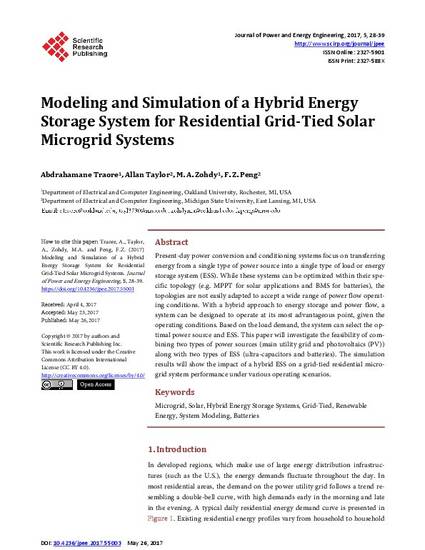
Article
Modeling and Simulation of a Hybrid Energy Storage System for Residential Grid-tied Solar Microgrid Systems
Journal of Power and Energy Engineering
(2017)
Abstract
Present-day power conversion and conditioning systems focus on transferring energy from a single type of power source into a single type of load or energy storage system (ESS). While these systems can be optimized within their specific topology (e.g. MPPT for solar applications and BMS for batteries), the topologies are not easily adapted to accept a wide range of power flow operating conditions. With a hybrid approach to energy storage and power flow, a system can be designed to operate at its most advantageous point, given the operating conditions. Based on the load demand, the system can select the optimal power source and ESS. This paper will investigate the feasibility of combining two types of power sources (main utility grid and photovoltaics (PV)) along with two types of ESS (ultra-capacitors and batteries). The simulation results will show the impact of a hybrid ESS on a grid-tied residential microgrid system performance under various operating scenarios.
Keywords
- Microgrid,
- Solar,
- Hybrid energy storage systems,
- Grid-tied,
- Renewable energy,
- System modeling,
- Batteries
Disciplines
Publication Date
May 1, 2017
DOI
https://doi.org/10.4236/jpee.2017.55003
Publisher Statement
Copyright © 2017 by authors and Scientific Research Publishing Inc. This work is licensed under the Creative Commons Attribution International License (CC BY 4.0).
Citation Information
A. Traore, Allan R Taylor, M. A. Zohdy and F. Z. Peng. "Modeling and Simulation of a Hybrid Energy Storage System for Residential Grid-tied Solar Microgrid Systems" Journal of Power and Energy Engineering Vol. 5 Iss. 5 (2017) p. 28 - 39 ISSN: 2327-588X Available at: http://works.bepress.com/allan-taylor/25/
